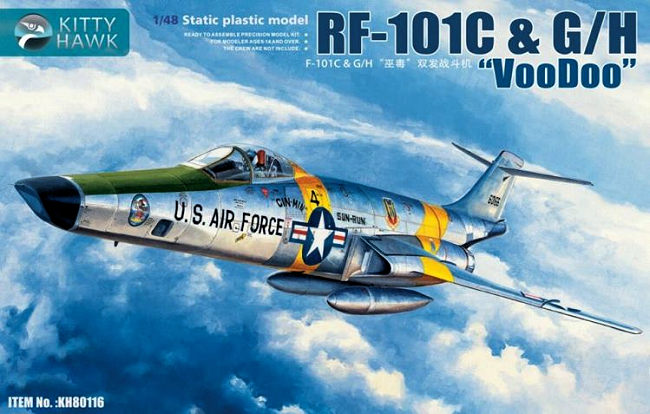
Kitty Hawk 1/48 RF-101C/G/H Voodoo
| KIT #: | KH80116 |
| PRICE: | $ |
| DECALS: | Five options |
| REVIEWER: | Scott Van Aken |
| NOTES: | 2018 boxing |

| HISTORY |
Using the reinforced airframe of the F-101C, the RF-101C first flew on 12 July 1957, entering service in 1958. Like the RF-101A, the RF-101C had up to six cameras in place of radar and cannons in the reshaped nose and retained the bombing ability of the fighter-bomber versions. 166 RF-101Cs were built, including 96 originally scheduled to be F-101C fighter-bombers.
The 1964 Project "Toy Tiger" fitted some RF-101C with a new camera package and a centerline pod for photo-flash cartridges. Some were further upgraded under the Mod 1181 program with automatic control for the cameras.
The RF-101C saw service during the Cuban Missile Crisis and soon followed the North American F-100 Super Sabres in October 1961, into combat when RF-101s from the 67th Tactical Reconnaissance Wing deployed to Vietnam. The RF-101C was deployed operationally during the Vietnam War, sustaining losses with the first F-101 being lost in November 1964 to ground fire. From 1965 through November 1970, its role was gradually taken over by the RF-4C Phantom II. In some 35,000 sorties, 39 aircraft were lost, 33 in combat, including five to SAMs, one to an airfield attack, and one in air combat to a MiG-21 in September 1967. The RF-101C's speed made it largely immune to MiG interception. 27 of the combat losses occurred on reconnaissance missions over North Vietnam. In April 1967, ALQ-71 ECM pods were fitted to provide some protection against SAMs. Although the Voodoo was again able to operate at medium altitudes, the added drag and weight decreased the speed enough to make RF-101 vulnerable to the maneuverable (and cannon-equipped) MiGs and thus requiring fighter escort.
On 27 November 1957 during Operation Sun Run, an RF-101C piloted by then-Captain Robert Sweet set the Los Angeles-New York City-Los Angeles record in 6 hours 46 minutes, and the New York to Los Angeles record in 3 hours, 36 minutes. Another RF-101C, piloted by then-Lieutenant Gustav Klatt, set a Los Angeles to New York record of 3 hours 7 minutes.
After withdrawal from Vietnam, the RF-101C continued to serve with USAF units through 1979.
In service, the RF-101C was nicknamed the "Long Bird;" it was the only version of the Voodoo to see combat.
Twenty-nine surviving F-101As were converted to RF-101G specifications with a modified nose, housing reconnaissance cameras in place of cannons and radar. These served with the Air National Guard through 1972. Thirty-two F-101C aircraft were later converted for unarmed reconnaissance use under the RF-101H designation. They served with Air National Guard units until 1972.
| THE KIT |
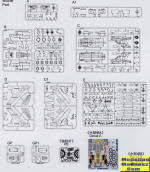 Kitty Hawk may well have saved the best for last. This is the only 1/48
single seat recce Voodoo kit to have been done and a most welcome presentation.
If you have built any of their earlier F-101 kits, then this one will be quite
familiar as the only real difference is in the forward fuselage/nose area. Those
are where the camera housings are located.
Kitty Hawk may well have saved the best for last. This is the only 1/48
single seat recce Voodoo kit to have been done and a most welcome presentation.
If you have built any of their earlier F-101 kits, then this one will be quite
familiar as the only real difference is in the forward fuselage/nose area. Those
are where the camera housings are located.
Interestingly, the kit starts you off building up the center
fuselage. This consists of a full intake section and the afterburners. Once the
rear keel between the exhaust is added, then the upper fuselage section and
burner cans are added. There are p.e. bits to fit into the burner cans. KH then
has you build up the wings complete with the landing gear. Ailerons are separate
and the flaps can be posed lowered. T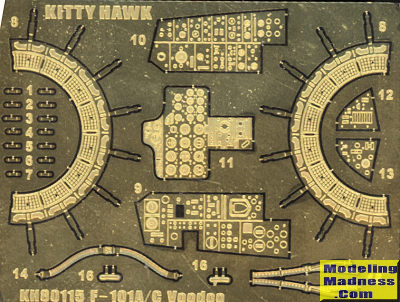
Once that is done, the wings and fin can be attached to the fuselage. On the fuselage are air scoop inserts and you have the option to have the speed brakes open or closed. This is when the rudder and horizontal stab are installed as is the tail hook.
It is only halfway through the build that the cockpit is assembled. The kit has a four piece bang seat with p.e. harness. P.e is also used for the instrument panels and side consoles. These are fairly flat and some folks don't like them, preferring raised details i.e. Monogram's F-101B. You have decals you can place over these if you wish. Kitty Hawk provides different forward nose sections for the C and the G/H along with four assembly steps per variation. It is here that you need to make up your mind as to which version you will be doing. There are no cameras so you basically paint the interior of the nose black. Unlike previous kits, there is nothing in the nose avionics bays either so those doors are cemented shut. A good place for weight, though I'm not sure if this will need it as the wheelbase is fairly long. This and the cockpit are then attached to the nose gear well. Again, instructions show the nose gear assembly being built up prior to closing the nose halves.
The G/H version has an air refueling probe just forward of the windscreen and this can be modeled extended. The only items for under the wings are two fuel tanks as the recce birds were unarmed.
Instructions are well done, though they don't beat you
on the head when it comes time choose variants so I can see those who don't pay
attention wanting to do the C starting in on the G/H before realizing it. The
decal sheet is very nicely done and provides five options. One is the 'Sun Run'
box art plane in unpainted metal. All the yellow on this plane will need to be
painted. Not the case with the other USAF unpainted metal plane, which is from
the 15th
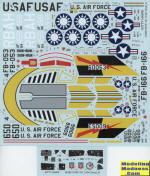 TRS.
All the yellow bits for this one are provided. Then there is another unca
TRS.
All the yellow bits for this one are provided. Then there is another unca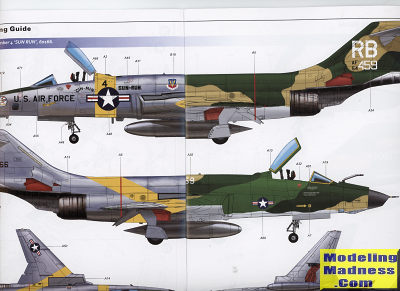 mouflaged
plane as operated by the ROKAF. Then we have a camouflaged plane from the 45th
TRS with the AH tail code and one RF-101G/H with an RB tail code with the 154th
TRS, Arkansas ANG. The instructions provide no unit information nor are the
decal placement pages offering any color information for the camouflage schemes.
In addition, someone at KH brain farted and printed all the decal placement
pages as if they were the centerfold. It means that other than the center pages,
all the others have one scheme on one side and one on the other. It looks
confusing, but the builder can open the staples and remove the page that applies
to the scheme they are using.
mouflaged
plane as operated by the ROKAF. Then we have a camouflaged plane from the 45th
TRS with the AH tail code and one RF-101G/H with an RB tail code with the 154th
TRS, Arkansas ANG. The instructions provide no unit information nor are the
decal placement pages offering any color information for the camouflage schemes.
In addition, someone at KH brain farted and printed all the decal placement
pages as if they were the centerfold. It means that other than the center pages,
all the others have one scheme on one side and one on the other. It looks
confusing, but the builder can open the staples and remove the page that applies
to the scheme they are using.
| CONCLUSIONS |
I think this may well complete the series Voodoo kits from Kitty Hawk. You can now build every version of this aircraft that saw service in 1/48 scale. The kit is not a toss-together, but careful building will produce an excellent model. Well worth picking up. I am equally sure that the aftermarket folks will be producing stuff for this kit, if that sort of thing is what you like.
| REFERENCES |
https://en.wikipedia.org/wiki/McDonnell_F-101_Voodoo
August 2018 Copyright ModelingMadness.com. All rights
reserved Thanks to Kitty Hawk for the review copy. Get yours at your
favorite retailer. If you would like your product reviewed fairly and
fairly quickly, please
contact
the editor or see other details in the
Note to
Contributors.